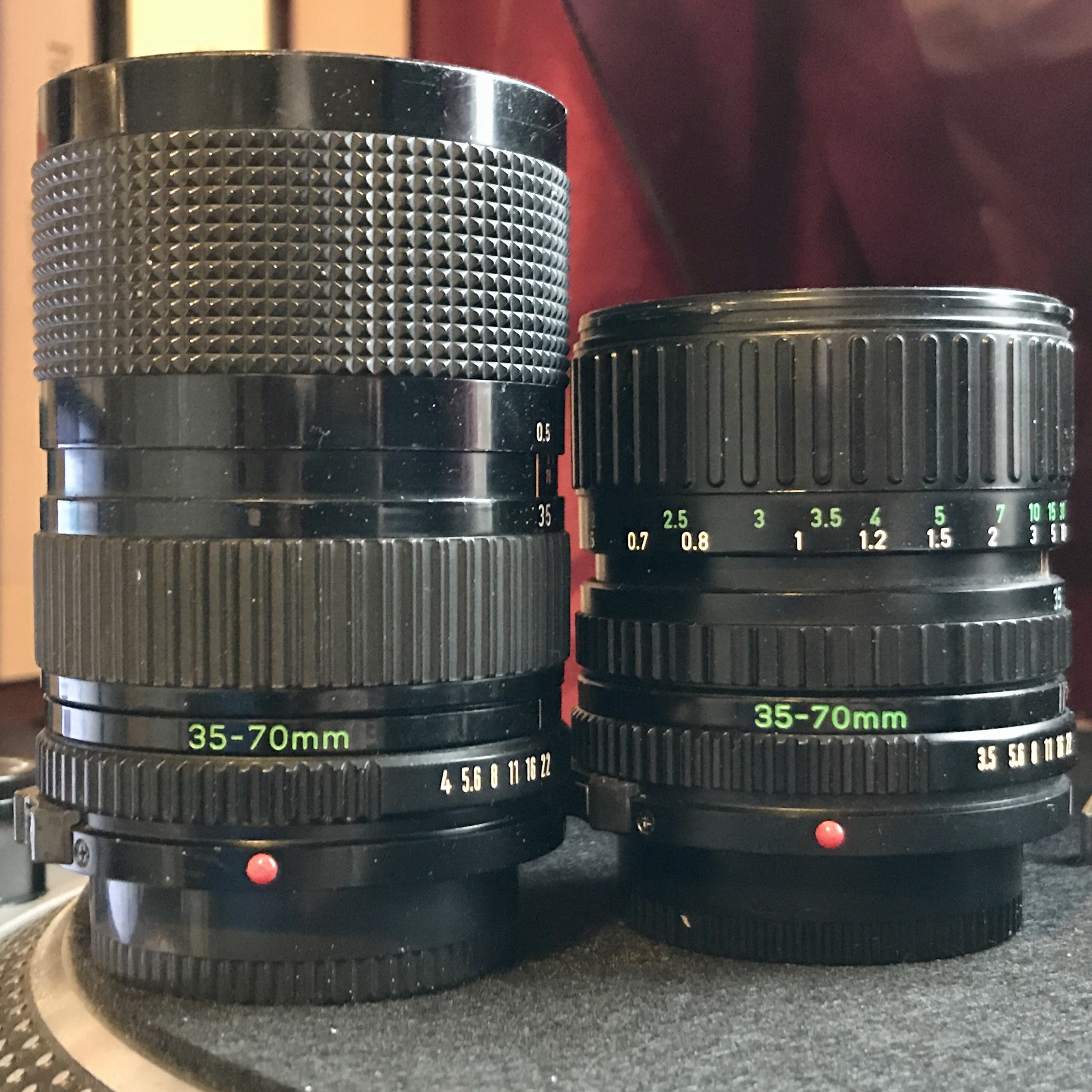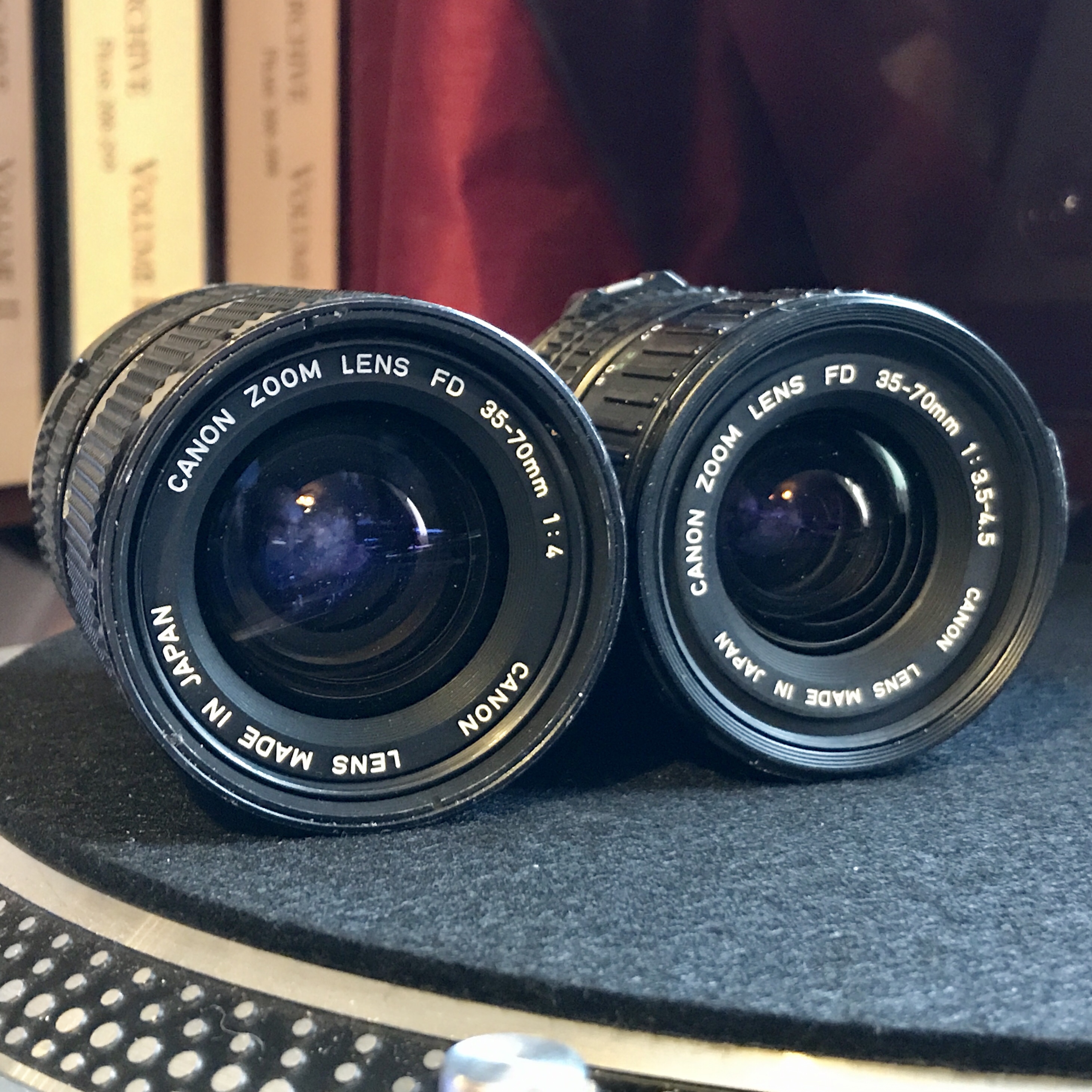In the late 1970s and early 1980s, Canon released these two similar lenses as part of their New FD series – both 35-70mm zoom lenses. But what’s the difference between these two lenses, and which is better?
First, let’s cover the similarities. These are both compact zoom lenses with the same focal lengths from the New FD lineup, with bayonet mount instead of the original FD lenses with their silver breech ring. They are both double-touch zoom lenses, with separate rings for zoom and focus.
The key difference between them is their aperture – at first glance the smaller lens has the slightly faster aperture of f/3.5-4.5 while the larger lens has an aperture of f/4.
However, the f/4 version can manage f/4 at all focal lengths while the f/3.5-4.5 version can only manage f/3.5 at 35mm, falling to f/4.5 at 70mm.
There are obvious physical differences, too. The f/4 version is longer and heavier as it seems to have more metal components. The f/3.5-4.5 version feels plasticky in comparison.
Specifications
Let’s have a look at the specs on paper and see what they reveal.
| New FD 35-70mm f/4 | New FD 35-70mm f/3.5-4.5 | |
|---|---|---|
| June 1979 | Marketed | March 1983 |
| 45,000 yen | Original Price | 31,900 yen |
| 8/8 | Elements/Groups | 9/8 |
| 6 | Diaphragm blades | 8 |
| 22 | Minimum aperture | 22 |
| 0.5m | Closest Focusing Distance | 0.5m |
| 0.15× | Maximum Magnification | 0.15× |
| 52mm | Filter Diameter | 52mm |
| 63 × 84.5mm | Max Diameter × Length | 63 × 60.9mm |
| 315g | Weight | 200g |
Looking at these specifications is a mixed bag. The optical formula is very similar but has been altered, with the addition of an extra element, which is presumably to improve image quality.
As already mentioned, the new lens weighs less and uses more plastic, which is consistent with camera design in the 1980s. We can see that it was priced lower at launch. But it also has a greater number of diaphragm blades – something which is usually associated with more expensive lenses.
A little bit of context
Let’s take a moment to consider the context that these lenses were marketed in. The f/4 model was marketed in 1979, just one year after the New FD system was launched in 1978. There was a flood of new lenses and improved versions of existing ones, but this 35-70mm f/4 was a new design. Cameras released around this time include the A-1 and AV-1, which both included 50mm prime lenses as their “kit” lens (50mm f/1.4 and 50mm f/2.0 respectively). So this zoom lens was a premium item marketed as an upgrade.
Meanwhile, the f/3.5-4.5 lens was released in 1983 with the T50. The T series were the first Canon cameras to openly embrace the use of plastics, and were much lighter. This lens appeared as the kit lens on the T50 and the T70 the following year.
My verdict
I haven’t done any thorough side-by-side testing of these lenses but I think they are both pretty decent performers.
Going by the rest of the data, the earlier f/4 is the superior lens as it occupied a higher position in the lineup, and the f/3.5-4.5 was built to a budget as a kit lens. It’s a more solid lens and probably has slightly better image quality.
However, I would still pick the f/3.5-4.5 over the f/4 if I needed a small and light lens to go with a small and light camera.
CameraHub
If you like nerding out over camera and lens data, you should check out CameraHub. It’s a public database of camera and lens data that anyone can edit and add to. It’s browseable and searchable but to get you started, here are a few links to cameras and lenses mentioned in this article:






